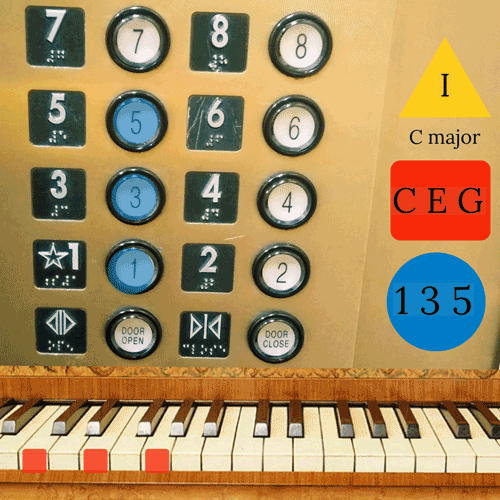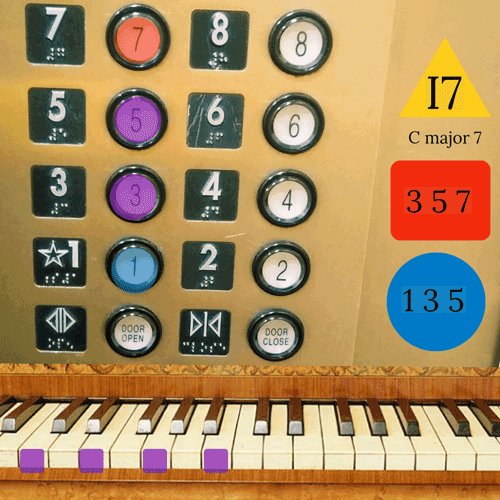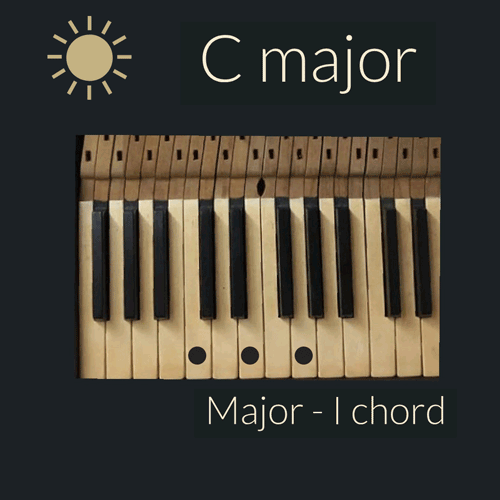#1 - Learn the C major scale using numbers, letters and solfege syllable.
#2 - In diatonic harmony, each note of the major scale is the root of a chord. These 3 note chords are called triads. The upper case roman numerals are major triads, while the lower case are minor triads. The 7 triads of the diatonic scale are sometimes referred to as a chord family. These are the most common chords used for creating chord progressions.
#3 - Most instruments have the ability to play the different octaves of the same note. This creates the option to create different versions by rearranging the order the notes are played in, also known as an inversion. When the root is played as the lowest note (1 3 5), this is called root position. Switching the root note to the octave inverts the chord, leaving the 3rd in the lowest position (3 5 1) and is known as first position. Putting the 3rd in the upper octave and leaving the 5th as the lowest note (5 1 3) is another inversion known as 2nd position.
#4 - Triads consist of every other note in the major scale ( 135, 246, 357, etc.), and are the most basic chord in diatonic harmony. Seventh chords add the next note in the sequence, creating a 4 note chord (1357, 2468, 3579 etc.). One way of understanding that has a very practical application is that 7th chords are built up of two triads with the two notes in the middle overlapping. If someone is strumming a C major triad on the guitar, the piano player can play an E minor triad on the piano. Together, the guitar player and piano player are creating a major 7th chord. If you are alone and only have a piano, try playing C major triad with your left hand, and E minor triad with your right hand. This will also create C major 7.
#5 - Every major chord has a relative minor. Every day has night, light cannot exist without creating a shadow. If you know how to play 3 major chords and their relative minor chords, you know almost all the chords in diatonic harmony! It is very important to understand the relationship between chords, because then you can have a better idea of how to use them. Understanding relationships between chords is much more important then learning a bunch of random chords without knowing how to use them.
#6 - A note can be understood as a fixed pitch, or in relationship to other notes. In reality, each note is fixed and relative at the same time, and the better you can understand this intuitively, the more useful it will be to you.
#7 - Most people know the major and minor scale. This is good enough when you are learning the basics, however in order to understand the bigger picture it is important to learn the modes. I think of major and minor like a light switch that goes on or off, whereas the modes are like a dimmer switch the give the ability to see a lot more subtle shades of light and dark. Notice how each mode has one more flat key, adding a subtle level of complexity as each scale becomes a little bit darker.
#8 - Each note is a fixed pitch, it also exist relative to many other notes. A note might be many things in the same song, depending on its place in the harmony. Sometimes the note could be the leading note of the melody, or sometimes just a supporting note in the harmony, while other times it is establishing the root. In life, a person plays many roles, sometimes the hero, sometimes the antagonist, sometimes the center of attention, sometimes a member of the audience, sometimes creating dissonance, other times creating harmony. At different times, and sometimes simultaneously, we are all these things.








